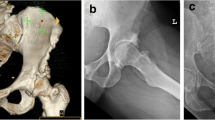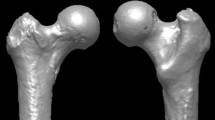Abstract
Purpose
The acetabular labrum is theorized to be important to normal hip function by creating intra-articular fluid pressurization through the hip fluid seal. However, the effect of a labral tear or partial labral resection, and interventions including labral repair and labral reconstruction, on the hip fluid seal remains to be defined. The purpose of this study was to characterize intra-articular fluid pressurization in six labral conditions: intact, tear, repair (looped vs. through sutures), partial resection, reconstruction with iliotibial band, and complete resection.
Methods
Eight cadaveric hips with a mean age of 47.8 years (SD 4.3, range 41–51) were included in the study. For each labral condition, the hip was compressed with a force of 2.7 times body weight (2,118 N) while intra-articular pressure was continuously measured with 1.0 × 0.3 mm pressure transducers. Peak intra-articular pressure measurements for each condition were normalized relative to the intact state. Statistical analyses were performed utilizing linear mixed-effects models with repeated measures analysis.
Results
Intra-articular fluid pressurization of the intact state varied from 78 to 422 kPa (mean 188 kPa ± SD 120). Labral tear, partial resection, and complete resection resulted in average pressurization of 75 ± 33, 53 ± 37, and 24 ± 18 %, respectively compared with the intact state. Through type labral repair resulted in significantly greater increases in pressurization from the labral tear state, compared with the looped type repair (median increase; +46 vs. −12 %, p = 0.029). Labral reconstruction resulted in a mean pressurization of 110 ± 38 % relative to intact state, with a significant 56 ± 47 % improvement in pressurization compared with partial labral resection (p = 0.009).
Conclusions
Partial labral resection caused significant decreases in intra-articular fluid pressurization. Through type labral suture repair restored the fluid pressurization better than looped type repairs. Labral reconstruction significantly improved pressurization to levels similar to the intact state. This study demonstrated the effect of labral tears and partial resections on intra-articular fluid pressurization via the hip fluid seal, and it also demonstrated improvements in pressurization seen with through type labral repairs and labral reconstructions.




Similar content being viewed by others
References
Bergmann G, Deuretzbacher G, Heller M, Graichen F, Rohlmann A, Strauss J, Duda GN (2001) Hip contact forces and gait patterns from routine activities. J Biomech 34(7):859–871
Boykin RE, Patterson DC, Briggs KK, Dee A, Philippon MJ (2013) Results of arthroscopic labral reconstruction of the hip in elite athletes. Am J Sports Med 41(10):2296–2301
Cadet ER, Chan AK, Vorys GC, Gardner T, Yin B (2012) Investigation of the preservation of the fluid seal effect in the repaired, partially resected, and reconstructed acetabular labrum in a cadaveric hip model. Am J Sports Med 40(10):2218–2223
Crawford MJ, Dy CJ, Alexander JW, Thompson M, Schroder SJ, Vega CE, Patel RV, Miller AR, McCarthy JC, Lowe WR, Noble PC (2007) The 2007 Frank Stinchfield Award. The biomechanics of the hip labrum and the stability of the hip. Clin Orthop Relat Res 465:16–22
Espinosa N, Rothenfluh DA, Beck M, Ganz R, Leunig M (2006) Treatment of femoro-acetabular impingement: preliminary results of labral refixation. J Bone Joint Surg Am 88(5):925–935
Ferguson SJ, Bryant JT, Ganz R, Ito K (2003) An in vitro investigation of the acetabular labral seal in hip joint mechanics. J Biomech 36(2):171–178
Ferguson SJ, Bryant JT, Ganz R, Ito K (2000) The acetabular labrum seal: a poroelastic finite element model. Clin Biomech 15(6):463–468
Ferguson SJ, Bryant JT, Ganz R, Ito K (2000) The influence of the acetabular labrum on hip joint cartilage consolidation: a poroelastic finite element model. J Biomech 33(8):953–960
Ganz R, Parvizi J, Beck M, Leunig M, Nötzli H, Siebenrock KA (2003) Femoroacetabular impingement: a cause for osteoarthritis of the hip. Clin Orthop Relat Res 417:112–120
Ganz R, Leunig M, Leunig-Ganz K, Harris WH (2008) The etiology of osteoarthritis of the hip. Clin Orthop Relat Res 466:264–272
Geyer MR, Philippon MJ, Fagrelius TS, Briggs KK (2013) Acetabular labral reconstruction with an iliotibial band autograft: outcome and survivorship analysis at minimum 3-year follow-up. Am J Sports Med 41(8):1750–1756
Haemer JM, Carter DR, Giori NJ (2012) The low permeability of healthy meniscus and labrum limit articular cartilage consolidation and maintain fluid load support in the knee and hip. J Biomech 45(8):1450–1456
Henak CR, Ellis BJ, Harris MD, Anderson AE, Peters CL, Weiss JA (2011) Role of the acetabular labrum in load support across the hip joint. J Biomech 44(12):2201–2206
Ishiko T, Naito M, Moriyama S (2005) Tensile properties of the human acetabular labrum-the first report. J Orthop Res 23(6):1448–1453
Konrath GA, Hamel AJ, Olson SA, Bay B, Sharkey NA (1998) The role of the acetabular labrum and the transverse acetabular ligament in load transmission in the hip. J Bone Joint Surg Am 80(12):1781–1788
Krych AJ, Thompson M, Knutson Z, Scoon J, Coleman SH (2013) Arthroscopic labral repair versus selective labral debridement in female patients with femoroacetabular impingement: a prospective randomized study. Arthroscopy 29(1):46–53
Larson CM, Giveans MR, Stone RM (2012) Arthroscopic debridement versus refixation of the acetabular labrum associated with femoroacetabular impingement: mean 3.5-year follow-up. Am J Sports Med 40(5):1015–1021
Nepple JJ, Martel JM, Kim Y-J, Zaltz I, Clohisy JC, ANCHOR Study Group (2012) Do plain radiographs correlate with CT for imaging of cam-type femoroacetabular impingement? Clin Orthop Relat Res 470(12):3313–3320
Paley D (ed) (2005) Principles of deformity correction. Springer, Berlin
Philippon MJ, Briggs KK, Hay CJ, Kuppersmith DA, Dewing CB, Huang MJ (2010) Arthroscopic labral reconstruction in the hip using iliotibial band autograft: technique and early outcomes. Arthroscopy 26(6):750–756
Pollard TC, Villar RN, Norton MR, Fern ED, Williams MR, Simpson DJ, Murray DW, Carr AJ (2010) Femoroacetabular impingement and classification of the cam deformity: the reference interval in normal hips. Acta Orthop 81(1):134–141
Soltz MA, Ateshian GA (1998) Experimental verification and theoretical prediction of cartilage interstitial fluid pressurization at an impermeable contact interface in confined compression. J Biomech 31(10):927–934
Song Y, Ito H, Kourtis L, Safran MR, Carter DR, Giori NJ (2012) Articular cartilage friction increases in hip joints after the removal of acetabular labrum. J Biomech 45(3):524–530
Takechi H, Nagashima H, Ito S (1982) Intra-articular pressure of the hip joint outside and inside. Nihon Seikeigeka Gakkai Zasshi 56(6):529–536
Terayama K, Takei T, Nakada K (1980) Joint space of the human knee and hip joint under a static load. Eng Med 9:67–74
Weber W, Weber E (1837) Uber die mechanik der menschlichten gehwerkzeuge nebst der beschreibung eines versuches uber das herausfallen des schenkelkopfes aus der pfanne im luftverdennten raum. Ann Phys Chem 40:1–13
Acknowledgments
We would like to thank Penny Bortz, RN and Jane Roehrig, RN for their assistance in labral reconstruction graft preparation and Kelly Adair for his assistance in specimen acquisition.
Conflict of interest
Smith & Nephew Endoscopy provided unrestricted in-kind donations of the surgical tools utilized in this study.
Author information
Authors and Affiliations
Corresponding author
Additional information
Investigation performed at the Department of BioMedical Engineering of the Steadman Philippon Research Institute, Vail, CO.
Rights and permissions
About this article
Cite this article
Philippon, M.J., Nepple, J.J., Campbell, K.J. et al. The hip fluid seal—Part I: the effect of an acetabular labral tear, repair, resection, and reconstruction on hip fluid pressurization. Knee Surg Sports Traumatol Arthrosc 22, 722–729 (2014). https://doi.org/10.1007/s00167-014-2874-z
Received:
Accepted:
Published:
Issue Date:
DOI: https://doi.org/10.1007/s00167-014-2874-z




